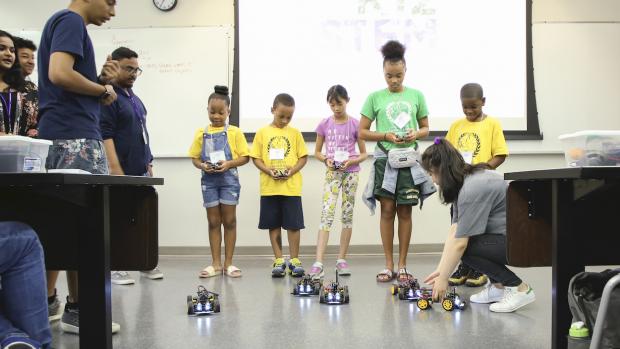STEMnow showcase puts smart cities, robots, and more on display

Anyone who asserts that teachers have an easy job because they get summers off has never met Elizabeth Jacob of University Heights High School in the Bronx or Kouassi Lucien of Brooklyn Friends. They were just two of the dozens of New York City teachers taking part in NYU Tandon’s STEMnow programs, aimed at engaging K-12 students, teachers, and schools in science, technology, engineering, and math (STEM) through intense, hands-on learning.
This summer, the two collaborated to coach a team of high school students in building robots capable of addressing New York City’s garbage issues. Funded by the National Science Foundation and overseen by Professor of Mechanical and Aerospace Engineering Vikram Kapila, the Innovative Technology Experiences for Students and Teachers (ITEST) program, allowed Jacob, Lucien, and their fellow teachers to develop a curriculum that they can take back to their respective classrooms in the fall — all while the participating students (drawn from a variety of schools) dove into the world of sensors, Arduino microcontrollers, and Vex Robotics tools.
Tandon’s MakerSpace became a hub of robotic activity on August 2, as student teams explained their ideas — with Jacob and Lucien’s group proudly displaying their RoboCan prototype, which could pick up garbage from homes and businesses and take it to the appropriate recycling facility thanks to an effective array of color sensors — and navigated their bots over a grid schematic using light detection and ranging (LiDAR) technology.
“The month spent at Tandon will pay off all year long back at my school,” Jacob said, noting that Tandon graduate students will visit periodically to help with the curriculum and serve as mentors. “My students are excited to learn about robotics and I’m excited to pass along everything I’ve learned, developed, and done here.”
While the robots roamed the MakerSpace, elsewhere in Rogers Hall participants in Tandon’s Science of Smart Cities (SoSC) program were setting up elaborate and ambitious dioramas that showcased their talents as budding urban planners.
“I had heard the term ‘smart city’ before, but I hadn’t given much thought to what went into actually making a city smart,” Munazza Choudhury, a seventh grader from NEST+m (New Explorations in Science, Technology and Math), a school for gifted K-12 students on the Lower East Side, said. “We spent three weeks learning about the topic and a week building our model, and now I’m motivated to learn even more, so maybe I’ll be able to participate again next summer.” It’s hard to imagine Choudhury and other members of her cohort topping themselves; the smart-city models on display featured carefully considered transportation hubs, interconnected elevators, movement-sensitive streetlights, underground reservoirs, thoughtfully placed recreational areas, and in one case, even a “smart” movie marquee.
Also displaying their innovations were participants in the Innovation, Entrepreneurship and the Science of Smart Cities (ieSoSC) program. Created as a follow-up experience to Science of Smart Cities, ieSoSC (which was funded by National Grid) resulted in several solid ideas that could be of interest to municipal agencies and other such groups. One such idea is iKar, smart-highway technology that detects mishaps and within seconds posts them on signage to alert other drivers to danger ahead. Another team sought to ease subway commuting by deploying an array of sensors that, when combined with an app, will tell riders which train cars have available seats and which are the most comfortable temperatures. Another group was inspired (and repelled) by the now ubiquitous posters warning New Yorkers of “fatbergs,” conglomerations of non-biodegradable solids like baby wipes and congealed grease; in response they designed a sewer system that uses sensors and shunts to move the masses out of the flow of manageable material.
More efficient sewer systems, better ways to recycle, smarter urban transportation systems: it all adds up to an enriching and productive way to spend the summer in Brooklyn.





